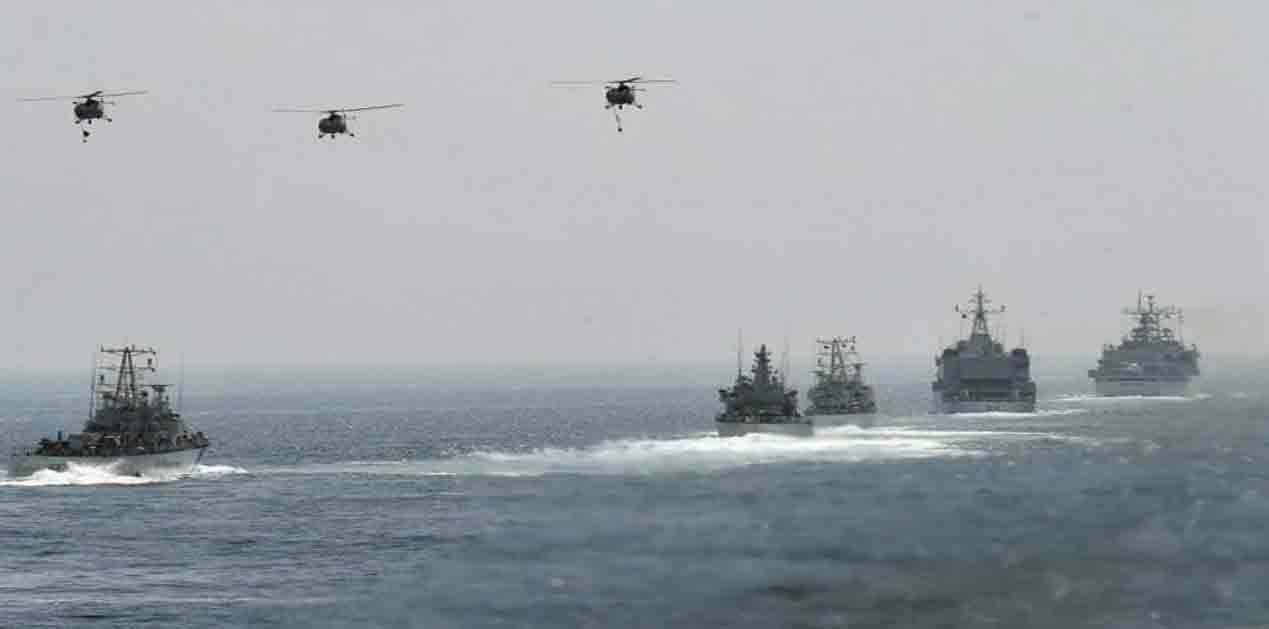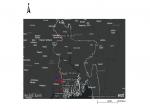India and Australia have conducted the third edition of biennial naval exercise AUSINDEX-2019 from April 2-14, 2019 at Vishakhapatnam. The Harbor Phase of the Exercise was conducted from April 2-7, 2019 followed by Sea Phase from April 7-11, 2019 with the De-briefing or the Harbor Phase was conducted from April 12-14, 2019, in which new objectives were set for the next AUSINDEX-2021. The AUSINDEX exercise 2021 will be hosted by Royal Australian Navy.

AUSINDEX-2019 was hosted by the Eastern Naval Command of Indian Navy Similar to the previous editions in the Bay of Bengal with the core emphasis on anti-submarine warfare (ASW). Along with ASW operations the exercise was focused on strengthening professional interaction, enhance abilities to undertake joint or combined regional operations in humanitarian assistance and disaster relief, and eventually aimed at achieving interoperability between the two navies. The Indian Navy was represented by INS Sindhukirti, a conventional submarine, INS Ranvijay, a stealth destroyer, INS Kiltan ASW corvette, and INS Kora, a missile corvette 1. The air component from the Indian Navy included land-based Hawk aircraft and P-8i Neptune ASW aircraft. The Royal Australian Navy (RAN) was represented by HMAS Canberra amphibious assault ship, also the largest vessel in the RAN, HMAS Newcastle Adelaide-Class guided missile frigate, HMAS Paramatta frigate, HMAS Collins conventional submarine, and HMAS Success replenishment vessel 2. The air components of the Australian Navy included the MRH-90 and MH-60R embarked helicopters; additionally, this year, the Australian version of P8A and ASW helicopter also participated3.

Bilateral Security Cooperation
A military exercise or security cooperation is undertaken between two (or more) nations when there is an element of commonality with respect to threats and common security concerns. So what brings India and Australia together? Both India and Australia are Indian Ocean nations. There are common concerns regarding maritime security issues such as peace and stability, free and open sea lanes, safeguarding against threats emanating from piracy, natural disasters, and common interest in maritime trade. The bulk of Canberra’s economic activity is located to its North-East and its general strategic orientation is in the Pacific but it has begun to look towards the Indian Ocean as part of its strategic orientation towards its west.
India and Australia have a strategic partnership and both countries signed the Framework for Security Cooperation in November 2014 during the visit of Prime Minister Narendra Modi to Australia. Six areas were identified under the framework 4:-
- Annual summit and foreign policy exchanges and coordination, that also includes track 1.5 dialogue.
- Defence policy planning and coordination that provides for annual defence ministers meetings regular bilateral maritime exercise.
- Cooperation on Counter-terrorism and other transnational crimes include exchanges on cyber policy and coordination.
- Cooperation between coast guards and customs authorities.
- Dialogue and cooperation on disarmament, non-proliferation, maritime security.
- Disaster management and security.
- Cooperation in regional and multilateral fora.
While we proceed to examine the factors that are driving closer cooperation between the two Indian Ocean countries in the recent past, one should bear in mind that bilateral relations were not always close. Some understanding of the history of bilateral relations will be useful. Both India and Australia were erstwhile British colonies. On account of the heritage of the Royal Navy, Indian and Australian navies of that time shared the same equipment. Later, with the passage of time and the division of the world into two blocks, India and Australia were not in each other’s strategic calculus. From the Indian point of view, Australia was seen as part of a US-led setup, something that India was reticent about in the Cold War period given its non-aligned foreign policy.
The end of the Cold War brought wide opportunities in international relations. India could freely engage across the spectrum of states. Likewise, as the shadows of the ideological rivalry faded away, the world began to take interest in India. Many navies, and particularly the US Navy, were interested in establishing relations with the Indian Navy. The world took notice of the Indian Navy’s impressive role in responding to the 2004 Indian Ocean tsunami. It was second only to the US Navy in the Indian Ocean in terms of size and capabilities. As far as the Australian Navy is concerned, it had some interaction with the Indian Navy in the aftermath of the 2004 tsunami. Both the navies cooperated in disaster relief in Indonesia. Eventually, India and Australia became strategic partners in 2009. This was the culmination of the Australia perception that sought a potential partner in India to contribute to regional peace and stability.
A major thorny issue in the bilateral relationship has been over the matter of sale of Uranium. Australia had objections to selling uranium to India due to the fact that India is not a signatory to the Non-Proliferation Treaty (NPT). In 2012, the government led by Julia Gillard overturned the ban on selling Uranium to India, and in 2014 both sides finally inked the agreement after negotiations.
The first ever AUSINDEX was in September 2015 in Vishakhapatnam. The second AUSINDEX was held in Freemantle in 2017. Indo-Australia relations are in the process of transformation.

Growing Relevance of ASW Operations in Indian Ocean Region (IOR)
The growing sub-surface presence of China in the Indian Ocean is a matter of great concern for India. A Chinese Yuan-class submarine visited Karachi in May 2015, and in July 2018, two Chinese submarines – a Type 091 Han-class nuclear powered submarine and a Type 039 Song-class diesel-electric submarine - were found docked at Karachi through satellite imagery 5.
Despite India’s concerns, a Chinese conventional submarine surfaced in the Sri Lankan waters in 20146. Chinese submarines have been active in the Indian Ocean claiming that they were on anti-piracy operations, though submarines are hardly the equipment of choice when it comes to anti-piracy operations. Activities of the People’s Liberation Army Navy (PLAN) have alerted India because under the guise of anti-piracy operations, the PLAN submarines are said to perform stand-alone missions that would eventually pave the way for permanent PLAN deployment in the Indian Ocean. This has been analysed by Ramanand Garge as an indicator of the growing confidence of the Chinese navy to “maneuver and maintain its standing presence in areas of the Indian Ocean Region where the Indian Navy has remained virtually unchallenged.”7

India has enhanced its cooperation with the United States and Japan and the three navies conduct exercises under the aegis of the Malabar Exercise in the Arabian Sea. The foundation to the Malabar Exercise was in September 2015 when the first US-India-Japan trilateral was held on the sidelines of the 70th United Nations General Assembly. The trilateral was indicative of the growing convergence of security interests in the Indo-Pacific wherein the three navies aimed towards inter-operability8. Australia has been sending requests for inclusion in the Malabar Exercise. India has reasons (which will be elaborated further in the article) for not expanding the Malabar Exercise at the moment.
Indo-Pacific Security and India- Australia Relations
Bilateral relationship between Indian Ocean countries, Australia and India needs to be understood in the context of the emerging concept of the Indo-Pacific, as well as the Quadrilateral Security Dialogue (QUAD).
Australia is a US ally and India is an important strategic partner of the US. Australia has been trying to participate in Malabar Exercise but there is a background to India’s non-acceptance. In 2007, when Australia was to participate in the Exercise, it withdrew its participation at the last moment, presumably under pressure from China9. The Indians, as also the other two members of Exercise were taken aback by Australia’s abrupt withdrawal. This incident, it is said, has made New Delhi reluctant to bring back Australia into the Malabar Exercise. However, this neither paints the complete nor an accurate picture. A more nuanced analysis points to the direction of the QUAD and its implications.
The QUAD - a dialogue between India, US, Japan, and Australia - was first formed in 2007 but it fizzled out almost immediately. The QUAD grouping was envisioned in the light of a growing China, and initiated by Japan in the year 2007. But such an arrangement was deemed uncomfortable by Australia owing to its dynamics with China. Australia gives a lot of importance to its ties with China. A few months after the abrupt withdrawal from the Malabar Exercise, Yang Jeichi the Chinese foreign minister visited Canberra and Prime Minister Kevin Rudd of the Labour Party announced withdrawal from the QUAD. The QUAD fell apart because it was seen as a risky endeavor at that time. But in recent times, voices for the revival of the QUAD have resurfaced due to the aggressive posture of China, and the QUAD held its first meeting at the level of officials in 2017. India does not want the Malabar Exercise to be seen as a military manifestation of QUAD; or in other words, a military initiative of the QUAD members. Second, Australia’s consistent political instability, when there have been six prime ministers in the last nine years, creates some diffidence about its consistency in foreign policy.
Therefore, at the moment the Malabar configuration is left unaffected - letting it remain a trilateral exercise amongst India, Japan, and the US. But, in due recognition of Australia’s strategic importance, India has invested into a bilateral security relationship. Australia’s absence from the Malabar Exercise is duly compensated through the emerging bilateral security relationship seen through exercise like the AUSINDEX.
Way Ahead
Both the countries had, and continue to have, extensive economic ties with China so this factor will remain important. China is Australia's largest trading partner and accounts for about 28.8 percent of Australia's exports (2015 data) the bilateral trade is valued at USD 183 billion, and Australia is the only country that enjoys a trade surplus with China. Australia’s concerns over antagonising China are therefore understandable10 11. The politics in Australia is also sharply divided over China. In the past Australia is said to have made conciliatory approaches to China and has not participated in the US-led freedom of navigation operations in the South China Sea12 13. But increasingly, Canberra has come to accept the challenge that China possess and the possible implications if it were to emerge as a regional hegemon. It therefore, sees value in hedging and its efforts to build security relations with India are part of its strategy to cooperate with like-minded countries like US and Japan. In 2018 Australia asserted its right to conduct freedom of navigation exercise in the South China Sea14.
India too has its calculations with respect to China considering the shared and contested land border. India is deeply concerned with increasing Chinese presence in the Indian Ocean. The US vision of its Indo-Pacific strategy seeks an active partnership of India, and a larger role for India across the Malacca Straits. India’s priorities lie in the Chinese expansion activities in the Indian Ocean. Australia's interest and presence as an Indian Ocean power serve as a natural partnership over the common geographical expanse. It is important that both sides continue to build trust and ensure that the momentum gained through AUSINDEX is kept up and Australian non-participation in the Malabar Exercise is not seen as a rebuff by Australia.
References:
- ‘Royal Australian Navy Ships and Submarine at Visakhapatnam to Participate in AUSINDEX-19’ at https://www.indiannavy.nic.in/node/22460 (Accessed April 1, 2019).
- Shubhajit Roy, 'Eye on Indian Ocean, India-Australia joint naval exercise to begin April 2', The Indian Express, New Delhi, March 26, 2019 at) https://indianexpress.com/article/india/eye-on-indian-ocean-india-australia-joint-naval-exercise-to-begin-april-2-5642658/ (Accessed April 1, 2019).
- Op. cit : 1.
- ‘Framework for Security Cooperation between Australia and India 2014’ at https://dfat.gov.au/geo/india/Pages/framework-for-security-cooperation-between-australia-and-india-2014.aspx
- “Satellite imagery reveals presence of Chinese nuclear submarine in Karachi” at //economictimes.indiatimes.com/articleshow/56375723.cms?from=mdr&utm_source=contentofinterest&utm_medium=text&utm_campaign=cppst (Accessed April 3, 2019).
- “Chinese submarine docks in Sri Lanka despite Indian concerns” at https://www.reuters.com/article/sri-lanka-china-submarine/chinese-submarine-docks-in-sri-lanka-despite-indian-concerns-idINKBN0IM0LU20141102 (Accessed April 2, 2019).
- Ramanand Garge,’ AUSINDEX- Mid Power Bonhomie in the Indo-Pacific’ Australian Journal of Maritime and Ocean Affairs 2016.
- Op. cit: 9.
- Abhijit Singh "India-Australia relations: Getting over the Quad blues" at
https://www.lowyinstitute.org/the-interpreter/india-australia-relations-getting-over-quad-blues (Accessed April 1, 2019). - Gregory O’Brien, "Australia’s trade in figures", Parliament of Australia at)
https://www.aph.gov.au/About_Parliament/Parliamentary_Departments/Parliamentary_Library/pubs/BriefingBook45p/AustraliaTrade (Accessed April 2, 2019). - Edmund Tang, (2018) "Australia’s two-way trade with the world was up 11% to $763 billion in 2017" https://www.austrade.gov.au/news/economic-analysis/australias-two-way-trade-with-the-world-was-up-11-to-763-billion-in-2017 (Accessed April 2, 2019).
- "Will Australia Join South China Sea FONOPs? Don’t Count on It"
https://www.cfr.org/blog/will-australia-join-south-china-sea-fonops-dont-count-it (Accessed April 2, 2019). - Bethany Allen-Ebrahimian, (2017), " It’s Not China, It’s You, India Seems to Tell Spurned Aussies" , Foreign Policy https://foreignpolicy.com/2017/06/05/its-not-china-its-you-india-seems-to-tell-spurned-aussies-malabar-australia-navy/ (Accessed April 1, 2019).
- “Australia asserts right to South China Sea passage” at https://www.straitstimes.com/asia/australianz/australia-asserts-right-to-south-china-sea-passage (Accessed April 10, 2018).
Image Source: https://www.deccanherald.com/sites/dh/files/styles/article_detail/public/article_images/2019/03/25/naval-exercise-pti-1553506202.jpg?itok=pasWVL7u











Post new comment